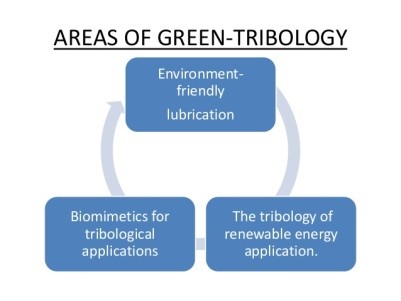Administration of the project
Principles of Green Tribology
Peter Jost first used the term tribology in 1966 to describe the studies of science and technology that aim to understand how surfaces in relative motion to each other interact and the effects those interactions consequently have on the materials involved. Essentially, tribology started as the study of friction, wear, and lubrication. Due to industrial concerns regarding the costs of corrosion, friction, and wear, the field of tribology has grown exponentially all around the world. While tribology traditionally deals with adhesion, friction, lubrication, and wear, it has expanded to include studies in biotribology (a term coined in 1970 by Duncan Dowson for the study of those areas of tribology dealing with biological systems), nanotribology (the branch of tribology that studies adhesion, friction, lubrication and wear at the nanoscale level), and green tribology.
Green tribology is a branch within the broader field of tribology that works to keep an ecological balance regarding the potential negative impacts on the environment. Green tribology works to ensure that friction and wear of any materials does not negatively affect the environment. It also deals with solar panels, tidal panels, and wind powered turbines. The field of green tribology continues to expand to include research regarding minimizing noise pollution as well as saving energy and resources, to improve the quality of life on planet Earth.
Green tribology, green engineering and green chemistry all aim to reduce the negative impacts of industry on the environment and human health. Green engineering focuses more on the actual design of products to minimize the production of pollution while green chemistry focuses on the design of chemical products or processes to minimize their harmful impact on the environment. Green tribology is more interdisciplinary in nature, integrating both green engineering and green chemistry concepts within its studies.
In “Green Tribology: Principles, Research Areas and Challenges” (https://royalsocietypublishing.org/doi/pdf/10.1098/rsta.2010.0200) by Nosonovsky and Bhushan discuss the three main aspects of tribology, biomimetic (synthetic methods that mimic biochemical processes) and self-lubricating surfaces and materials, environmentally friendly and biodegradable lubrications, and renewable/sustainable sources of energy.

Building on these three areas, Nosonovsky and Bhushan developed the twelve principles of green tribology.
The first two principles are the minimization of heat and energy dissipation, and the minimization of wear. These are considered to be the most important roles of tribology as they pertain to green tribology. Minimizing heat and energy dissipation involves reducing friction, which is the primary cause behind the losses. Reducing friction and wear is a primary concern across industries as both reduce the efficiency and effectiveness of machinery while shortening the lifespan of said machinery.
The concept of lubrication is the focus of the next four principles, reducing or eliminating lubrication and self-lubrication, encouraging the use of natural and/or biodegradable lubrication, and following green chemistry and green engineering principles. All are designed to reduce the negative impact lubricants have on the environment.
Surfaces are the focus of the next four principles, employing biomimetic approaches, using surface texturing, looking at the environmental impact of surface coating, texturing, etc., and improving the design of surfaces and coatings to minimize degradation. All four principles emphasize the importance of producing surfaces and coatings that mimic biology, with minimal impact on the environment.
Finally, the last two principles look at the future focus of green tribology. The first focus is to monitor and analyse tribological systems to ensure that they are not producing harmful or hazardous substances. The second focus is to place an emphasis on developing sustainable energy applications.
The increasing emphasis on green technology in our global society is a positive step towards protecting our environment.


Be the first to comment